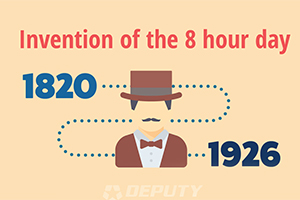 The 8-hour workday dates back to the 19th-century. It was designed to split the day into three equal parts (work, free-time, and sleep). Given the heavily industrial nature of work in those days, and the rise of labor unions to protect workers, the 8-hour workday not only became commonplace, but was also legislated with additional protections for over-time. Nearly 100 years later, most organizations still cling to the 8-hour workday, in spite of the dramatically different landscape of the workplace today.
The 8-hour workday dates back to the 19th-century. It was designed to split the day into three equal parts (work, free-time, and sleep). Given the heavily industrial nature of work in those days, and the rise of labor unions to protect workers, the 8-hour workday not only became commonplace, but was also legislated with additional protections for over-time. Nearly 100 years later, most organizations still cling to the 8-hour workday, in spite of the dramatically different landscape of the workplace today.
Given the global nature of business, advances in technology, and our understanding of human behavior, it’s surprising that the 8-hour workday still is the standard. Not only that, but for most organizations the hours are usually confined to 8 am-5 pm. But 2020 may be the year that forces us to reconsider if the standard workday is still the best solution for achieving business objectives while acknowledging individual needs.
Even before the Corona virus pandemic, workers were choosing to work from home more often. While many organizations had concerns that working from home would reduce productivity, collaboration, and creativity, they had little choice when Stay-at-Home orders were issued in an effort to flatten the curve of rising infection rates. In a recent article in Harvard Business Review, we now have data to explore how the shift to remote work has impacted productivity and collaboration.
While the article notes that the data itself should be taken in context (i.e., nothing about 2020 has been “normal”), it is a great opportunity to see what we can learn from an overnight shift to fully remote teams. One of the findings included the fact that the workday lengthened by approximately 4 hours once everyone began working remotely. One theory behind the change is that workers are logging on earlier in the morning or later in the evening because they’ve taken more breaks during the day due to lack of childcare. It’s possible they have to work longer hours because they can’t find extended time to focus without distractions, or they’re breaking up their days with more intentional breaks to interact with their families.
The data point isn’t necessarily good or bad, but should be considered within the context of the organizational culture, and with an eye towards ensuring employees are still able to find a healthy work-life balance. As someone who is most creative in the evenings, I tend to delay projects that involve writing until late at night. This is a time when I know I can focus with minimal interruptions from email, IM, social media, and my family. That may be an argument against retaining the structured 8-hour workday. However, if that extra time spent working in the evenings is in addition to a full 8-hour workday, then organizations need to consider how they protect employees from becoming overworked/burnt out. While many organizations may not yet have data to prove that their employees are working longer hours, my suspicion is they can sense the exhaustion. I’ve seen more Out of Office responses referencing summer hours and office closures to allow for extended weekends than usual.
It will take time to identify if current work trends reflect the new nature of remote work, or if the data is more of a reflection on Covid-related abnormalities in the workplace. Regardless, this is a great time for an open conversation (or even a survey) to identify if the structured 8-hour workday is still the best approach. At a time when we have no choice but to adapt, let’s ensure we’re aligning towards the future and not the past.
